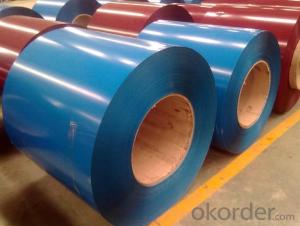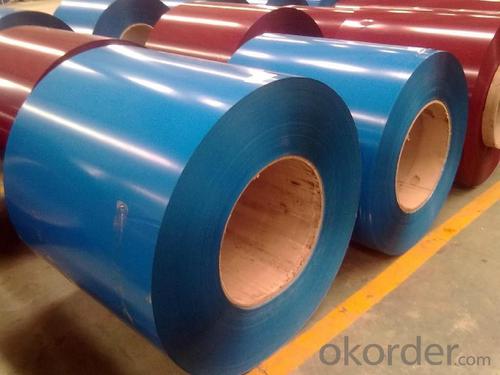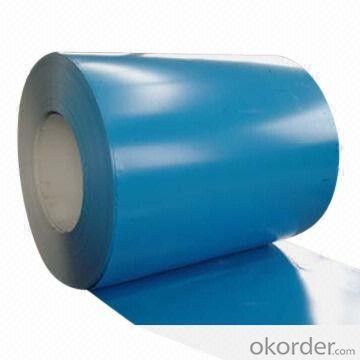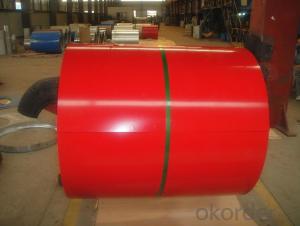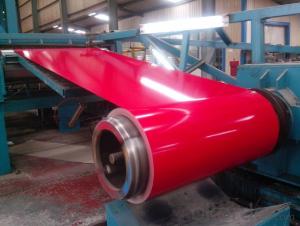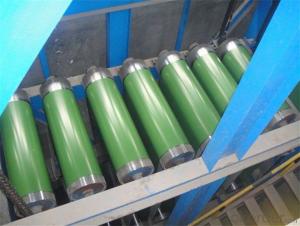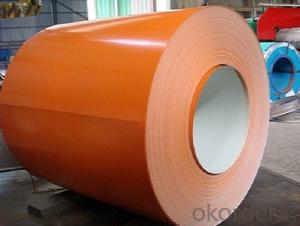prepainted aluminum Zinc rolled Coil for Construction
- Loading Port:
- Shanghai
- Payment Terms:
- TT OR LC
- Min Order Qty:
- 25 m.t.
- Supply Capability:
- 30000 m.t./month
OKorder Service Pledge
OKorder Financial Service
You Might Also Like
Structure of Aluminum Zinc Rolled Coil
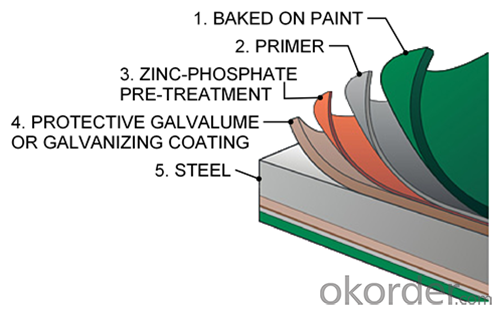
Description of Aluminum Zinc Rolled Coil
Aluminum zinc coils is a kind of coated steel coil/sheet. With the cold rolled steel of different strength and thickness as substrate, it is produced through applying Al-Zn coat on both faces by hot dip process. In its coating, Al accounts for about 55%, Si 1.6%, while the remaining is Zn. Aluminum zinc coils enjoys both the physical protective feature and durability of Al and the electrochemical protective property of Zn. And its surface has bright silver color and regular embossed-like figure, which are highly decorative.
Main Feature of Aluminum Zinc Rolled Coil for Construction Roof
1.Corrosion resistance: It mainly depends on the aluminum protection. When the zinc being worn, the aluminum will form a dense layer of aluminum oxide, resist corrosion material to prevent further corrosion inside.
2. Heat resistance: Aluminum zinc alloy steel sheet has excellent heat resistance, can withstand high temperatures over 300 centigrade, and is similar with aluminized steel high temperature oxidation resistance. It often used in chimney pipes, ovens, fluorescent lighting device and the device cover.
3. Heat reflective: Galvanized steel plate heat-reflective high rate is twice as galvanized steel, often used to make insulation materials.
4. Economy: Because density of 55% AL-Zn is smaller than the density of Zn, so in the same weight and thickness of Galvanized zinc layer, aluminum-zinc steel plate is larger area more than 3% of galvanized steel sheet.
Applications of Aluminum Zinc Rolled Coil for Construction Roof
1. Construction and building: roofing; ventilating duct; handrail; partition panel;etc.
2. Electric appliance: refrigerator; washing machine; refrigerator; DVD;etc.
3.Transportation: oil tank; road sign; etc.
4.Agriculture:barn; etc.
5.Others:vending machine; game machine; etc.
Specifications of Prepainted Aluminum Zinc Rolled Coil for Construction
Chemical Composition | ||||||
GRADE | C | Si | Mn | P | S | Ti |
SGCC/DX51D+Z | ≤0.10 | ≤0.50 | ≤0.60 | ≤0.10 | ≤0.030 | ≤0.020 |
DX52D+Z | ≤0.10 | ≤0.50 | ≤0.60 | ≤0.10 | ≤0.030 | ≤0.020 |
SGCD/DX53D+Z | ≤0.10 | ≤0.30 | ≤0.50 | ≤0.05 | ≤0.030 | ≤0.020 |
SGCE/DX54D+Z | ≤0.10 | ≤0.30 | ≤0.30 | ≤0.03 | ≤0.020 | ≤0.020 |
DX56D+Z | ≤0.10 | ≤0.30 | ≤0.30 | ≤0.03 | ≤0.020 | ≤0.020 |
Structural | ≤0.20 | ≤0.60 | ≤1.70 | ≤0.10 | ≤0.045 | |
Mechanical Properties | ||||||
GRADE | Yield Strength MPa | Tensile Strength MPa | Elongation % | |||
SGCC(DX51D+Z) | ≥205 | ≥270 | - | |||
SGCD(DX53D+Z) | - | ≥270 | 38 | |||
SGCE(DX54D+Z) | - | ≥270 | 40 | |||
DX56D+Z | - | ≥270 | 42 | |||
FAQ of Prepainted Aluminum Zinc Rolled Coil for Construction
We have organized several common questions for our clients,may help you sincerely:
1. What is the minimum order quantity ?
Our MOQ is 50mt for each size. And we will consider to give more discount if you make big order like 1000 tons and more. Further more, the more appropriate payment term your offer the better price we can provide.
2. How long can we receive the product after purchase?
Usually within thirty working days after receiving buyer’s advance payment or LC. We will arrange the factory manufacturing as soon as possible. The cargo readiness usually takes 15-25 days, but the shipment will depend on the vessel situation.
3. How to guarantee the quality of the products?
We have established the international advanced quality management system,every link from raw material to final product we have strict quality test;We resolutely put an end to unqualified products flowing into the market. At the same time, we will provide necessary follow-up service assurance.
- Q: How are steel coils used in the manufacturing of automotive body panels?
- Steel coils are used in the manufacturing of automotive body panels by being processed and shaped into the desired form through techniques like stamping or roll forming. These coils provide the raw material for creating strong and durable body panels, ensuring the vehicle's structural integrity and safety.
- Q: How are steel coils used in the production of building systems?
- Steel coils are used in the production of building systems as they provide a cost-effective and versatile material for various construction applications. These coils are often processed and shaped into different components, such as beams, columns, and roofing materials, to meet the structural requirements of buildings. The strength and durability of steel make it an ideal choice for constructing high-rise buildings, industrial facilities, and other structures that require stability and longevity.
- Q: What are the dimensions of steel coils used in the structural component industry?
- The dimensions of steel coils used in the structural component industry can vary depending on the specific application and requirements. However, some common dimensions for steel coils used in this industry include a width ranging from 600mm to 2000mm and a thickness ranging from 0.25mm to 10mm. The weight of these coils can also vary, typically ranging from a few kilograms to several tonnes. Additionally, the length of the steel coils can be customized to meet the specific needs of the structural component industry, with common lengths being 2000mm, 2500mm, and 3000mm. It is important to note that these dimensions are not exhaustive and can vary based on the specific product and manufacturer.
- Q: I want to know the special characters or the advantages of the corton steel. In what cases it is recommended to use?Thank you.
- *It is Corten steel.Grade A B. *Weathering steel, best-known under the trademark COR-TEN steel, is a group of steel alloys which were developed to obviate the need for painting, and form a stable rust-like appearance if exposed to the weather for several years. United States Steel Corporation (USS) holds the registered trademark on the name COR-TEN. Although USS sold its discrete plate business to International Steel Group (now Arcelor-Mittal) in 2003, it still sells COR-TEN branded material in strip-mill plate and sheet forms. In some areas it may be known without the hyphen as Corten steel. The original COR-TEN received the standard designation A242 (COR-TEN A) from the ASTM International standards group. Newer ASTM grades are A588 (COR-TEN B) and A606 for thin sheet. All alloys are in common production and use. It is a weather-resistant steel which is used in containers and hot flue gas line. The American Corten A Steel has a composition of C, 0.12; Si, 0.5; Cu, 0.5; Cr, 0.8; P, 0.1 and Mn, 0.5%. Although the tensile strength is less than 494 MPa the yield is in the region of 371 MPa. The combination of copper and phosphorus also increases the resistance to atmospheric corrosion which is important when thinner plates are used. The original steel A suffers a decrease in yield strength and notch ductility in thickness over 25 mm, to overcome which Corten B was developed-C 0.14; P 0.04; Mn 1.1; Cr 0.5; Cu 0.4; V 0.1; Bol Al 0.02. *COR-TEN A applies to plates up to 12.5mm in thickness, COR-TEN B applies to plates up to 50mm in thickness. *It has been used in bridge and other large structural applications such as the New River Gorge Bridge, the newer span of the Newburgh-Beacon Bridge, and the creation of the Australian Centre for Contemporary Art (ACCA). It is very widely used in marine transportation, in the construction of shipping containers.
- Q: What are the different methods of surface inspection for steel coils?
- Steel coils can undergo surface inspection using various methods, each with its advantages and limitations. Among the commonly used techniques are: 1. Visual Inspection: Inspectors visually examine the steel coil surface for defects like scratches, dents, or discoloration. Though subjective and reliant on inspector expertise, this method proves cost-effective for detecting obvious defects. 2. Magnetic Particle Inspection (MPI): This method involves applying a magnetic field to the coil and then iron particles on the surface. Disruptions in the magnetic field caused by defects or cracks gather the particles, making the flaws visible. MPI effectively detects surface cracks and defects not easily seen by the naked eye. 3. Eddy Current Testing (ECT): ECT, a non-destructive testing method, employs electromagnetic induction to identify surface defects in steel coils. A probe with a coil generates an alternating magnetic field near the coil surface. Changes in electrical conductivity or magnetic permeability due to surface defects lead to a change in the induced current, which can be analyzed. ECT successfully identifies cracks, corrosion, and other surface irregularities. 4. Ultrasonic Testing (UT): High-frequency sound waves are used to examine both the surface and subsurface of steel coils. A transducer sends ultrasonic waves into the steel, and the reflected waves are analyzed to detect material changes or anomalies. UT effectively identifies cracks, delaminations, or voids within the coil, providing valuable insights into the steel's structural integrity. 5. Optical Inspection: This technique utilizes advanced imaging techniques like cameras or laser scanners to capture high-resolution images of the coil surface. These images are then analyzed for defects such as scratches, pits, or irregularities. Optical inspection provides detailed information and is often used alongside other methods for a comprehensive inspection. It is important to note that each method has its limitations and may be more suitable for specific defect types or surface conditions. Therefore, a combination of these techniques is often employed to ensure a thorough and accurate inspection of steel coils.
- Q: Which movie is better and why?I say Man of Steel!
- Pretty hard, I feel like Captain America The First Avenger had less flaws, but I more enjoyed Man Of Steel. I don't know why people didn't like how Cap first started out with advertising/singing and all that. I actually applauded Marvel for having the guts to stay true to the character's origin. Henry Cavill has the best look for Superman in my opinion, but I do agree with the critics that say he doesn't reflect the character's personality accurately. He's too dark, reminds me of Batman, but if he talked less. I disagree with the Superman killing conflict. True, the character is not a killer, but that's exactly why they wrote that in. Internal character conflict. Put him at war with himself. Plus, it gave the grand opportunity to give Doomsday his new origin, which I kinda liked. In the end, I'll say Man Of Steel, they really dove deep into that movie, it was well written and had a great plot. I loved seeing and learning more of Krypton. Crazy how I'm not even a huge Superman fan????
- Q: and what type of metal is steel?
- Steel is an alloy consisting mostly of iron, with a carbon content between 0.2% and 2.14% by weight (C:110–10Fe), depending on grade. Carbon is the most cost-effective alloying material for iron, but various other alloying elements are used such as manganese, chromium, vanadium, and tungsten. Carbon and other elements act as a hardening agent, preventing dislocations in the iron atom crystal lattice from sliding past one another. Varying the amount of alloying elements and form of their presence in the steel (solute elements, precipitated phase) controls qualities such as the hardness, ductility, and tensile strength of the resulting steel. Steel with increased carbon content can be made harder and stronger than iron, but is also more brittle.
- Q: What are the common storage defects in steel coils?
- Some common storage defects in steel coils include: 1. Staining or discoloration: If steel coils are not stored properly, they can be exposed to moisture or chemicals, leading to staining or discoloration. This can affect the appearance and quality of the steel. 2. Rust or corrosion: Steel is susceptible to rust and corrosion if it comes into contact with moisture or is stored in a humid environment. Rust can weaken the steel and compromise its integrity. 3. Coil deformation: Improper stacking or handling of steel coils can result in deformation or bending. This can occur when coils are stored on an uneven surface or subjected to excessive pressure or weight. 4. Surface damage: Steel coils can develop surface scratches, dents, or abrasions if they are mishandled during storage. This can be caused by improper stacking, handling, or transport of the coils. 5. Edge damage: If steel coils are not properly protected or secured during storage, the edges can become damaged. This can include chipping, cracking, or bending of the edges. Edge damage can affect the usability and safety of the steel coils. 6. Coil slippage: When steel coils are not securely stored or stacked, they can slip or roll off, causing damage to the coils themselves and potentially causing harm to nearby personnel or equipment. 7. Contamination: Steel coils can become contaminated if they are stored near or come into contact with substances such as dirt, oil, grease, or chemicals. Contaminants can affect the quality and performance of the steel. 8. Coil nesting: Inadequate spacing or stacking of steel coils can result in coil nesting, where one coil becomes embedded or nested within another. This can lead to damage to the coils, making them difficult to separate and use. To prevent these common storage defects, proper handling, storage, and protection measures should be implemented. This includes storing steel coils in a dry, well-ventilated area away from moisture and chemicals, using appropriate stacking and support structures, and providing adequate protection against impacts and contaminants. Regular inspections and maintenance should also be conducted to identify and address any potential defects or issues.
- Q: How are steel coils used in the production of electrical enclosures?
- Steel coils are used in the production of electrical enclosures as they are shaped and formed into sheets, which are then cut, bent, and welded to create the enclosure's structure. The steel coils provide the necessary strength and durability required to protect the electrical components inside the enclosure while also offering resistance to various environmental factors such as moisture, heat, and impact.
- Q: What are the common applications of hot-rolled steel coils?
- Hot-rolled steel coils possess distinctive characteristics and versatility, making them widely utilized in diverse industries. The following are some of the common uses of hot-rolled steel coils: 1. Automotive industry: Extensively employed in the automotive sector, hot-rolled steel coils are ideal for manufacturing components such as frames, doors, hoods, wheels, and chassis due to their strength and formability. This enables the production of durable and lightweight automotive parts. 2. Construction sector: Hot-rolled steel coils are widely employed in construction projects to manufacture structural components like beams, columns, and trusses. Their high strength and ductility make them suitable for withstanding heavy loads and providing structural stability. 3. Manufacturing industry: The manufacturing sector utilizes hot-rolled steel coils to produce a wide range of products including machinery parts, pipes, tubes, and equipment. Hot-rolled steel's excellent machinability and weldability allow for easy fabrication and customization according to specific manufacturing requirements. 4. Energy sector: The energy sector employs hot-rolled steel coils to manufacture pipelines, tanks, and other infrastructure required for oil and gas exploration, transmission, and storage. Hot-rolled steel's corrosion resistance and strength make it a preferred choice for such applications. 5. Appliances and furniture industry: Hot-rolled steel coils are used in the manufacturing of appliances such as refrigerators, ovens, and washing machines, as well as furniture components like frames and supports. The aesthetic appeal, durability, and cost-effectiveness of hot-rolled steel make it a popular choice in these industries. 6. Shipbuilding industry: The shipbuilding sector extensively relies on hot-rolled steel coils for constructing components like hulls, decks, and bulkheads. Hot-rolled steel's high tensile strength and corrosion resistance ensure the durability and longevity of ships in harsh marine environments. 7. Infrastructure and bridge construction: Hot-rolled steel coils are utilized in the construction of bridges, highways, and other infrastructure projects. The high strength and load-bearing capacity of hot-rolled steel make it suitable for supporting heavy traffic and withstanding dynamic loads. In conclusion, hot-rolled steel coils are utilized in various industries including automotive, construction, manufacturing, energy, appliances and furniture, shipbuilding, and infrastructure. The unique properties of hot-rolled steel, such as high strength, formability, and versatility, make it an indispensable material for a wide range of applications.
Send your message to us
prepainted aluminum Zinc rolled Coil for Construction
- Loading Port:
- Shanghai
- Payment Terms:
- TT OR LC
- Min Order Qty:
- 25 m.t.
- Supply Capability:
- 30000 m.t./month
OKorder Service Pledge
OKorder Financial Service
Similar products
Hot products
Hot Searches
Related keywords
